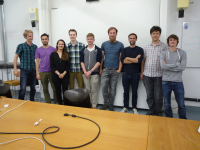Build-your-own Brain-Computer Interface

ETH D-ITET P&S Module Overview
Description: This module instructs students on the basics of building their own EEG setup to record real-time brain signals externally from the surface of their own scalp. The module will work through amplifier design, real-world filter design, signal processing, and data visualization. The module is strongly project-based, with two main phases. In the first phase, students build a multi-stage amplifier and filter setup to capture the EEG signals, convert the signals from analog to digital, and then process and visualize the signals in software on a host computer. At the end of this first phase, students can control a Pong paddle with their alpha waves. In the second half of their module, students divide up into teams of 2 or 3 to tackle a problem of their choosing, with examples given from biofeedback, eye tracking, deep learning, remote robotic control, and health monitoring.
Open to 3rd year students, up to a maximum of 12 students
Time: 4 hours per week
Instructor: Dr. Shih-Chii Liu
Language of Instruction: English
Prerequisites: Basic electronics and programming
TA: Enea Ceolini
Additional TAs: Ilya Kiselev, Adrian Huber, Danny Neil
Available Projects
Ready-to-go projects, with components and software:
- Advanced classifiers: using modern models from machine learning such as deep recurrent neural networks to build better and faster classifiers for EEG data.
- Multi-electrode setup: using multiple Arduinos and amplifiers, design a 16-channel EEG.
- Games: use the EEG to control an agent in a game like Pong.
Alternate Projects, to inspire further creativity:
- Improved filter design: employ filter design skills to build an optimized pre-amplifier that performs more cleaning of the signal before its conversion to digital.
- Easily-wearable design: determine how to use dry electrodes and local amplifiers to install in a headband for a consumer wearable device.
- Biofeedback: using EEG and EKG signals, design a system by which a user can train involuntary processes such as heart rate or alpha wave generation, or to mitigate issues like headaches.
- Sleep study: develop an application that monitors the subject while sleeping to monitor sleep quality.
- Eye tracking: using the EEG setup as an EMG, locate the gaze of the eye on a computer screen.
- Silent communication: using classifiers and training both the user and a software model, transmit a small vocabulary of words to a recipient, silently.
- Art: use the EEG to create interactive art.
- Mechanical Feedback: see effect of mechanical tapping on EEG signal
Schedule
Session: Thursday 1-5 pm
Starting date: Mar 2nd (Thursday)
Place: Institute of Neuroinformatics, Dungeon Lab, Y35 E 30, Uni Zurich Irchel Campus
Module ends: May 25th
Lectures/Labs
-
Mar 2 - Exploring characteristics of filters needed for EEG experiments. Construction of circuit for amplification of signals from EEG electrodes and construction of filters for extracting signals below 40Hz and rejecting line frequencies.
-
Mar 9 - Finishing characterization of amplifier.
-
Mar 16 - Software for signal acquisition and frequency analysis on EEG signals.
-
Mar 23 - Lecture on signal processing. Demo of setup with EEG electrodes, preamplifier, and signal acquisition.
-
Mar 30 - Lecture on classifiers. Working example on audio/video frequency discrimination.
-
Apr 6 - Project Construction/Recording/Experimentation
-
Apr 13 - Project Construction/Recording/Experimentation
-
Apr 20 - Easter Holidays (No Lecture)
-
Apr 27 - No Lecture
-
May 4 - Project Construction/Recording/Experimentation
-
May 11 - Project Construction/Recording/Experimentation
-
May 18 - Project Writeup
-
May 25 - Project Presentation
